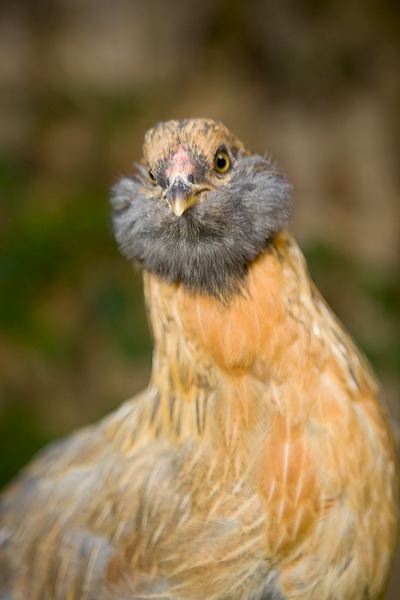
Edie with her beard
I’ve been so ashamed to admit that my pampered, pet chickens have mites that until recently I haven’t told a sole. I’ve spent many, many late night hours searching through the archives of backyardchicken.com educating myself on how to spot them and how to get rid of them. There are many different schools of thought, which, although helpful, has added to my confusion on how to deal with the problem.
My battle started a few months ago when I noticed Edie’s luxurious beard getting a little mangy looking. I bought a bag of diatomaceous earth and sprinkled it liberally inside their coop. Diatomaceous earth or DE for short, is fossilized diatoms or a hard-shelled algae. It’s tiny edges abrade soft-bodied animals that come into contact with it causing them to die of dehydration. You use food-grade DE with chickens (non-food-grade is lethal) to kill mites, lice and to deter flies. Some gardeners also sprinkle the stuff around their plants to protect them from slugs. When using DE, you must wear a dust mask and eye protection.
I also read that you need to dust your chickens. What the heck does a city girl know about how to dust a chicken?! I immediately turned to the internet, which has never let me down until this point. I was told to hold them upside down by their legs and sprinkle the DE all over them. Under wings, by their vent (chicken speak for poop shoot) and around their neck. You can put the DE in the foot of a stocking and use it like a powder puff. I thought for sure that YouTube would have a video showing me how to do that, but they didn’t. They have lots of videos of chickens rolling around in the dirt taking a voluntary dust bath in case you are interested in that? No? Okay. I also read that you can put DE in a plastic bag, put the chicken into the bag up to its neck and then just shake the bag. One person on the chicken forum made the connection to Shake N’ Bake and I can’t get that image out of my mind now. Plus I can’t figure out how to do that without strangling your chicken.
We then proceeded to have the rainiest June I can remember. Every time I dusted the chickens (which consisted of me sprinkling DE on them and then trying to massage it under their feathers) and their run it would rain. DE doesn’t work when it gets wet. Gah. Edie started to look mangier and her egg production fell off. When she layed eggs, they were strange – bumps on the shells, soft-shells, no shells. She didn’t act sick, but I knew that there was a problem. I bought some Poultry Protector and sprayed it in their coop and on them. Poultry Protector is a natural enzyme that kills mites, but isn’t harmful to the birds or the environment.
But the rain continued and I didn’t get rid of the mites. Or at least Edie’s neck and eggs still were in bad shape. Getting rid of mites is a bit like fighting an invisible boogey man. I could never see them, but I knew they were there. I decided to use different products. I stepped up a rung on the toxic spray ladder and bought some permethrin. I draw the line at Sevin, which a lot of people use to great success. What killed the Sevin for me was the part on the warning label that says it kills bees. I couldn’t be a part of the collapse of the honey bee population. Permethrin is derived from plants, which makes it sound less toxic, although it too has a pretty long list of warnings on the bottle. I sprayed the coop after I cleaned it thoroughly and I also sprayed the wood chips in the run. I also sprayed a little on the girl’s tushes. I washed Edie’s tush because it was getting a little dirty looking. I was horrified to see lots of missing and broken feathers. See thoroughly gross photo…
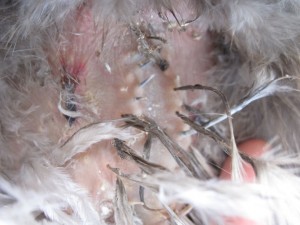
broken and missing vent feathers
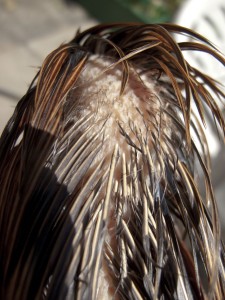
feathers missing on the back of Edie’s neck
I also bought flea and tick shampoo and powder. My toxic arsenal was getting larger!! They both contain permethrin in their ingredient lists. A lot of chicken keepers have success bathing their chickens in flea shampoo, so I thought I would give that a try. You see, you have to continue battling the chicken mites for a while to break their egg cycle. These products kill the mites, but not the eggs, so you have to do a second or third (or in my case 45th) round to make sure you catch all the hatching mites. The discouraging part is that even though you might kill all the mites in your immediate coop area, some mites can live for 6 weeks off their host and can come back to re-infest your flock.
So here are some photos of Edie after her flea bath. I put her in my daughter’s Lego tub and then lathered her up on the patio. I rinsed her several times with warm water to get the shampoo off of her. You have to make sure when doing this that your bird doesn’t get chilled. Even though it was a very warm and sunny day, I could feel her shivering a bit. I toweled her off and held her in the sunshine until she was dry. As you can see, she was not happy at all about being shampooed.
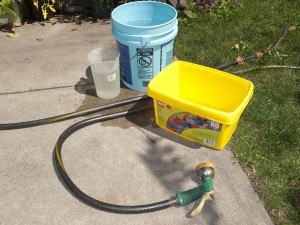
chicken washing station
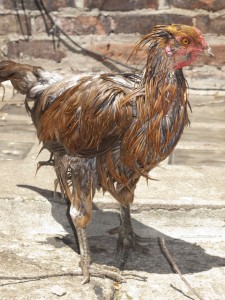
an angry wet hen
I also just ordered plastic roosting posts from Omlet as I read that mites can hide in the tiny cracks in wooden posts. When those arrive I will do another entire breakdown, scrubbing and dusting of their coop and run. Edie’s neck still looks very mangy, but I think I see some feathers growing in. I’ve been feeding all the girls yogurt (probiotics) and cat food (protein to help re-grow feathers), which they devour with gusto.
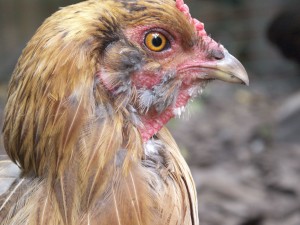
This has been a huge pain in the neck for both me and the hens and I hope I will get rid of the mites soon. Don’t worry about coming over, chicken mites don’t like humans. It’s just the thought of them that makes you itchy. And if someone wants to produce it with me, I think YouTube needs a video of how to dust a chicken.
Update: Since this post, I’ve learned that the mites do in fact bite humans. Many of my readers can vouch for that! And I did find YouTube videos for dusting a chicken. You can see some on my follow-up post here:
http://www.brooklynfeed.com/2011/05/dusting-your-chicken-for-mites/

Oh, you poor thing! I hope you’ve gotten rid of them, after all that, I think you must have! The permethrin was what worked for me, although I had lice, not mites. Poor Edie, too! She probably feels naked and ugly. I get the sense that chickens know they are beautiful 😉 I was wondering whether my chickens’ broken and missing feathers will grow back or if I will have to wait until they molt. Its been awhile and they are still looking ragged. I know the lice are gone though, because they were very visible. I am impressed with the “skin” photos you captured. It is difficult to take a picture of a chicken, much less a close-up of its skin. Thank you for your antidotal story!
Poor Edie. And my condolences on having to deal with the mites. Reminds me of my battle with the neighborhood head lice.
When my snake had mites (they hide under the scales and it’s very difficult to hold a slithering snake in water for any length of time to drown the damn mites) I placed the highly toxic (and now banned) pest strip on top of her tank. A week and mites & eggs were all dead & gone. These poisons work really fast and well.
I’m so sorry you have to deal with this. Unfortunately, I am in the same boat. We have 11 chickens and 1 turkey all in the same coop and they have mites too. It is going to be a long battle to fight them off, but your information has helped me out alot. Best of luck to you and Edie!
that chicken looks madder than a wet hen. ok, sorry. i couldn’t resist.
We have the same problem! We have 3 hens just down the street from you (Boerum Hill) they have been losing feathers. We assumed it was mites, but don’t know for sure. http://benjaminste.in/post/140448597/our-chickens-are-sick-2-of-them-are-losing
What is wrong with my chickens they lost alot of there feathers plz answer me i need help for my chickens thank you
the chicken losing all its feathers is probably molting, mine tend to stop laying and “shed”, some all at once, others not,this happens twice a year. its a natural phenomenon
The moulting suggestion is good. It’s hard to say without seeing or hearing about the feather loss. My girl had mites and her egg production went way down. I suggested moulting, but I haven’t heard back from Leigh just yet. Hopefully it’s moulting.
We used Ivomectin on our chickens (bought a big bottle used for cattle and reduced the dosage according to their weight.. about 1 drop for every 2 pounds, placed on the chickens skin) The chickens didn’t get sick and it killed the bugs. Now getting the coop cleaned out.. that is a whole different problem. These bugs seem to come back every other summer. Gah!
Your mites were around the head, I think mine are all on the top near the tail. I was given my hens and initially thought their featherlessness was due to too many hens in a small coop. Mine have plenty of room and free range all day, but still are not growing feathers. So I’m going to try dusting my hens as they come out the henny (doggie) door of my coop. Then I’ll dust everything inside. You didn’t say what the life cycle time is that I need to watch to redust everything. We’re getting ready for cold weather here in CO and I really need to get this taken care of right away. Thanks for the very graphic description of your fight against the mites.
Bev, Do you have any roosters? Sometimes the roosters tear off feathers as they get randy with the hens. If it is mites, their life cycle is about 10-14 days, so keep re-applying every few days to break the cycle. You may not see new feathers until your girls go through a molt. My hen Edie is molting now and looks like a porcupine with all the new quills coming in.
I finally decided to use Ivermectin on my girls. That was a couple of days ago, so let’s hope these critters are gone for a while.
thanks for the info. I have 8 chickens and the are starting to scrath and losing patches of feathers. some of them come in the house through the dog door and im concerned about getting them in the house too. I.ve been sprayeng with orange oil and it only seems to help a little.
You could make a dusting box for your chickens with dry earth and DE for them to roll in. My chickens love that and I have had no problems with mites.
Thanks Cindy,
I did make a dusting box with a mixture of DE, sand and fireplace ash. They didn’t get the idea, so I put them in it and sprinkled the mixture through their feathers. They thought they were being killed, so they never went near that box again!! I’m sure if I was patient, they would have lived in it!
If you have mites, you don’t have to worry about getting them. They are species specific and will not chomp on you like fleas do. I really recommend the eprinex/ivermectin pour on, which goes on the back of their necks like frontline for dogs and cats. You just put about 3-4 drops on them and the mites go away.
I have 37 chickens and cant figure out how to get rid of the mites. I have lots of lots of stuff written down that I want to try and your thing^ really helped me so thanks.
The folks at Cedarcide are using a modified cedar oil that will kill mites in about 30 seconds but won’t hurt you are the bird. Works for ticks , bedbugs, roaches and is a natural mosquito repellent.
To check it out email charlie@cedarcide.com
Thanks for this – it’s good to know that it is not just me dealing with this problem. I was recommended “Pestene” but am now worried that this is just the Australian name for “Sevin”. What are the active constituents? (This tube says :Sulfur” and “Rotenone” – am I killing my chooks?
I would definitely avoid Sevin in any form. I don’t know what the active ingredients are, but the warning labels will clue you in. Sevin has a warning about killing bees. I think the poor honey bees are having enough trouble without us tipping the scales. The Eprinex/Ivermectin pour on drops worked like a charm. 2-3 drops on a bantam and 3-4 drops on a regular sized chook. I have no affiliation with any of these products, I just try and find the least toxic. I also use Poultry Protector, but think that’s better as a preventative.
Thanks for that. I have managed to track down a seller of “Ivomec Eprinex Pour on” which is sold here in Australia for Cattle only and not recommended for chickens – would this be the right one?
That’s the stuff. Since it hasn’t been tested on chickens, there is no real info on how long (or if) you should wait before eating the eggs from the treated hens. I decided on 2 weeks, but then my girls went into a molt, so I didn’t have eggs anyway.
Help! I lost a hen about a month ago. I had no idea why,she was my first hen and I didn’t know a lot… She was spoiled rotten and we loved her dearly.. We have bought another hen from the fair and we have notice she stopped laying and is losing a lot of feathers. She seems to be off her food and lays around a lot. I did see tiny bugs around her vent area. Mite I’m guessing. I found some powder at one of the feed stores here and had no choice but to use it as It is the only thing I could find. She also has scaly feet too, I did the vaseline, but she hated it and started walking funny so I washed it off.. It the not eating and laying around that has me most bothered. We have no aviary vets here so I’m one mt own. Also none of our feed stores carry anything for poultry other than feed…I need to find help for her before it’s to late… I read that a lot of people use poultry spice when their chickens are under the weather.I could find it on line but only in the UK. Does anyone know about this stuff or anything close to it that I could find here? HELP! Debbie
It sounds as though you have a few problems. You should quarantine that hen ASAP so the others don’t get her problems. I’ve heard a lot of discussion of people finding sick hens at fairs. She has scaly leg mites and probably lice. Are the bugs around her vent yellowish or dark? Yellowish are lice and dark are mites. If she’s laying around she’s in distress. I would suggest going to backyardpoultry.com as they have loads of experienced chicken keepers who are very generous with advice. There is a forum and you go to the diseases and pests section to search for answers or post a question. I recommend a few drops of Eprinex pour on as a way to get rid of the lice/mites. I haven’t had experience with scaly leg mites, but I know it can get out of hand and be very bad for the hen. Why don’t you also google it and see what you can do. I think the vaseline is a good start. Probably the mites were getting smothered and starting to bite her, which was making her walk funny. I think you should put it back on her legs.
Good luck and keep me posted!
I am dealing with this exact situation now. People have told me for months I was watching my chickens too much, and they are just molting…HA! I found mites last night. My poor ladies!
So…I am on the mission to rid my coop and my ladies of mites! Thank you for the insight and help to do this task at hand…lots of work ahead!
Good luck Susan! My girls seem to get mites on a yearly basis. I try and keep diatomaceous earth in their nest box bedding and give them a place to take a dust bath. I also clean out the coop and spray it with Poultry Protector, which doesn’t have terrible chemicals.
Well, that post from Debbie with the chicken from the fair is really old. I wonder what happened. I did want her to know that chickens are flock creatures, they NEED company, she should have at least two chickens at a time. .
I was actually researching DE and sticky fleas and came upon your story. LOVED IT!
I have over 40 chickens and at least 15 chicks mostly year round. 7 Kennels with breeding birds and 1 acre. I am also at a loss where to start, dusting an acre plus killing all the earthworms would be awful, have used 7 but didnt know about the harm to bees (wont use that again), flea drops from vet I’d be bancrupt in 2 doses. Sprays, well I also have an aquaponics system and raise turtles that wouldn’t be a good idea either. Have been using de (diotomaceus earth) doesn’t seem to help much in the long run.
I’d never live down being the lady with all the buggy birds,,, whats next?
Since that post I discovered Eprinex/Ivomectin. They have one for cattle, that is a pour on type. The whole bottle costs around $35 and you only use 2-4 drops on each chicken. It’s like Frontline for chickens, but way less. I wait 1 week to eat their eggs, but some people don’t wait at all. I think it would be a good solution for you.
This was a great read! It is nice to see how others are using our product, Poultry Protector, to combat Fleas, Mites and other parasites.
Our company did, at one time, offer D.E. as product, alternative method, in fighting the mites. And, I would recommend it.
First mites will and do attack humans causing misery my entire house is infested with them but here is what i found works talstar p seven dust vapona onslaught painting perch with kerosene do not use these pesticides on the birds spray then with permithren and pyrethrens these are unless in the environment but work on birds
I would like to know if ivomectin or ivermectin? Are they the same? Is one better than the other. Does it get to the eggs? I have found it costly using the powder, cleaning, bathing and getting nowhere. Not to mention the time. This stuff sounds good is it? Where can i get it? Is there anything else, & cedar oil whats with that is it just for hen houses or for the chooks as well? If anyone can help it would be great. Thanks.
I am a big fan of Ivomectin (pour on). There isn’t much, if any, research about the affect on the eggs. I use 2-4 drops per hen and toss the eggs for a week or two. I know a woman who uses neem oil on her birds. I put diatomaceous earth in their nest box and under their roosts. When I scrub their coop I spray it down with Poultry Protector, which isn’t toxic like so many other options.
As with anything, there are many different approaches. I always try the mildest approach first and then climb the ladder until I hit on something that works. So sorry that you got mites in your home. That sounds awful. I never got mites on me and read that they don’t cross species, however I have had many people like you write opposing that belief.
http://www.youtube.com/watch?v=oVK8fwTLDMg
That’s a great video about dusting a chicken! Just did our 7 today with DE.
it is a fate worse than fleas, and far worse than mosqitoes
At some other web site I had found that feeding your chickens after treating them for mites a combo of ( not sure if dry or can) cat food and yogurt to help with the regrowth of feathers. Has any one tried this method and does it work. Thanks for any replys.
Hi Cindy,
thanks for this post. I was also very embarrassed that I didn’t protect my girls better. ?I am in a dry climate so the DE would work find in my state.
I did find a you tube video on this post on how to dust a chicken with DE.
http://mooboomoo.hubpages.com/hub/How-to-Eradicate-Red-Mite-from-your-Chickens-Naturally
good luck to anyone reading this post because they need help.
Take a peek at the link to this post entry of mine:
http://www.brooklynfeed.com/2012/06/feather-picking/
I am still having some issues with my girl’s feathers and I have been supplementing the protein in their feed to help with it.
Hi Danielle,
Thanks for the hilarious video of chicken dusting. You can take a peek at this post entry of mine to see some other methods. I think that some of them are slightly more thorough. But not as funny as yours when they are trying to catch the chickens!
we have been battling the mites for a while, of course we first thought it was fleas and were treating for them. What we have tried lately and seems to be working is placing three dehumidifiers in service and attempting to keep the humidity in the house <50%. We also set up water traps, which are bowls of water with a little dawn in them, under a light source in some rooms and without the light in others. It is also recommended to keep your dog out of the house for a couple of months (i have not been able to accomplish this yet, due to the heat).
Sevin dust on chickens shouldn’t cause any harm to bees. The warning on the label has to do with the use of Sevin on plants that bees pollinate. Bees shouldn’t be around chickens coops where the dust should be applied. Here’s how we do it: Have someone gently hold the chicken breast side up. Using rubber/vinyl gloves, rub a handful of the dust on the breast and vent areas working the dust under the feathers. You can apply it to the back also, but it is usually not necessary. That’s it. When you put the chicken down, it will shake and help spread the dust around the coop.
Thanks Tony. Good to know!
I think we have mites or lice . What is the difference? I can see teeny little creatures ,sort of light brown colour on the breast area of some of our chickens and myself and the children are getting more little red itchy bites every day . I want these critters gone now ! If Sevin dust is safe in the chook house, is it the most effective and should you discard the eggs for a few weeks? We live in south east Queensland ,hence it is now spring, is it likely to be a seasonal problem that will go with an increase in humidity?
Hi Liz,
I haven’t used Sevin dust. I am a big fan of Eprinex pour on. You use 2-4 drops on the back of the neck of each chicken (it must touch their skin). It is a lot like Frontline for pets. Don’t be deterred when you see that Eprinex (Ivomectin) says it is for cattle. That is why you use so little. I toss the eggs for 2 weeks after treatment. I’m so sorry you are having problems with the mites on your family. That is so disturbing! Good luck getting rid of the critters.
Hey guys I’m having the same problem I went to the fair and got 7 chickens and put them with my 20 chickens they all love each other but these last couple of day I’ve had 2 chickens die so I went out to checks for mites or lice and I found little whitesh color bugs all over them what r they and what do I do my kids r so sad and I don’t want to loose anymore please help
These minute little bugs do crawl onto humans if there is a big infestation. They don’t seem to bite but the crawling bugs is horrid. Will have to go to town tomorrow and get supplies before I go totally crazy. My girls are not laying at present. Would a pressure washer with dish detergent help clean up the hen house? I think I read somewhere that the soap disolves the critters shell/skin. How do I treat the dirt? Do I cover it with a layer of food grade DE? Is there something else I can use? Is Ivermectin the same as Eprinex?
Had a similar problem a few years back but cant remember exactly I did but whatever it was it worked!!
Thanks for all the coments as I am sure there are things U can try.
Ivomectin and Eprinex seem to be the same as far as I can tell. I get the pour on (which is for cattle), so I only use between 2-4 drops on the scruff of their necks. Make sure the drops hit the skin. I think your detergent idea is a good one. And I would also dust with DE. Wait till things have dried for the DE to be effective.
Good luck!!
Please Help!!! I am an animal lover–a few months ago just before winter set in a rooster and hen showed up in our yard—strange because none of the neighbors have chickens. They hung around for a couple days[a miracle they survived the fox and coyotes] and that night we had a cold pouring rain.
I couldn’t stand seeing them suffer so we went to a farm supply that sold us
a $300.00 pen. Definitely saw us coming, but it was shelter and snow was predicted. We bought the feed etc. that was advised and we placed a heat lamp in the pen for warmth since the shelter left alot to be desired. We went along great till the temperature was headed toward zero and I was concerned for keeping them warm so I sent my husband for a bale of straw,
what a mistake, I noticed the rooster lost alot of feathers on his breast and the hen lost hers under her wings and breast. I sought advise from the internet and the supply store but unsuccessful with a reason for the problem. The store asked what I changed and it was the straw so I removed it thinking it irritated them and went back to wood shavings. They seemed to be a little happier but she still was not producing eggs and all the irritation was still there. After research on the internet and the little information provided I suspected mites but there wasn’t a good solution given. Much to my surprise my hen started to not eat and just lying down and yesterday I was more than upset to find her dead!!!! I am heart sick—I loved having chickens even though it’s only been a few months but I need to find a solution to treat the rooster and get rid of the pests so as not to have this happen if I decide to bring chicks in {but only with a new coop} i’ll have to keep him away in the old coop. How do I get rid of the mites on him and the coop??? Anyone that can help I would appreciate it greatly!!!–I really shed some tears since the infested straw was my idea–and I examined her after her death and saw how bad she was infested with tiny black creatures.
I’m at the beginning of this journey & feeling overwhelmed by what lies ahead. These creatures DO cross species and they DO bite! Incredibly itchy bites that itch for days. Could this Ivomectin/Eprinex be used on humans too??? and where would I find it in suburban Australia? Desperately seeking solution.
Oh Catherine! I am so sorry to hear about your poor hen. Here are some thoughts for what they are worth.
1. $300 on a chicken coop doesn’t sound crazy. They seem to be pretty expensive, which is why some people make them themselves.
2. Unless you have supplemental light, hens won’t lay in the winter as a rule. Their egg laying is triggered by the number of hours of daylight. It seems right around groundhog’s day is when my girls start laying again.
3. Unfortunately you found out that straw can harbor mites. Not much help at this point, but try and buy hay next time. Straw is hollow, where hay isn’t. The mites seem to thrive in the hollow stems of straw.
4. You definitely have to help your poor rooster as soon as possible. Is he friendly enough to let you handle him? See if your farm supply store has ivomectin/eprinex. There is a pour on solution that is designated for cattle. You only need 2-4 drops for your rooster. Put the drops on the back of his neck, making sure you put it on his skin and not just on his feathers. That will be the best bet. In the very likely event that they don’t have this stuff, you should speak with them about what they do have. They may recommend Sevin, which a lot of people use. I’m not a fan because it’s environmental impact isn’t great. Kills fish and honeybees. There is also diotomaceous earth (make sure to get food grade!!), which you can dust all over your chicken. It isn’t great to breathe in, so cover your face and eyes. It’s natural. Take a peek at this link on my site to see videos of how people “dust” or “powder” their chickens.
http://www.brooklynfeed.com/2011/05/dusting-your-chicken-for-mites/
You can spread this powder in their coop after you remove all of the straw. You can also buy Poultry Protector to spray in the coop, which might be slightly easier to get in the nooks and crannies.
Good luck!!!!! Keep me posted on how you and your rooster make out.